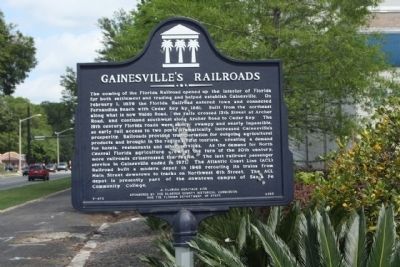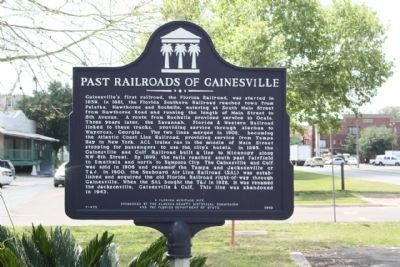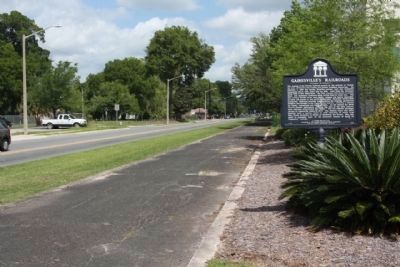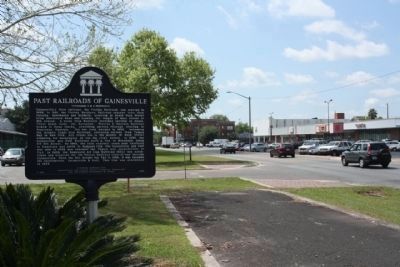Gainesville in Alachua County, Florida — The American South (South Atlantic)
Gainesville's Railroads / Past Railroads of Gainesville
The coming of the Florida Railroad opened up the interior of Florida for both settlement and trading and helped establish Gainesville. On February 1, 1859 the Florida Railroad entered town and connected Fernandina Beach with Cedar Key by 1861. Built from the northeast along what is now Waldo Road, the rails crossed 13th Street at Archer Road, and continued southwest along Archer Road to Cedar Key. The 19th century Florida roads were sandy, swampy and nearly impassible, so early rail access to two ports dramatically increased Gainesville's prosperity. Railroads provided transportation for outgoing agricultural products and brought in the region's first tourists, creating a demand for hotels, restaurants and other services. As the demand for North Central Florida agriculture grew at the turn of the 20th century, more railroads crisscrossed the region. The last railroad passenger service in Gainesville ended in 1971. The Atlantic Coast Line (ACL) Railroad built a modern depot in 1948 rerouting its trains from Main Street downtown to tracks on Northwest 6th Street. The ACL depot is presently part of the downtown campus of Santa Fe Community College.
Past Railroads of Gainesville
Gainesville's first railroad, the Florida Railroad, was started in 1859. In 1881, the Florida Southern Railroad reached town from Palatka, Hawthorne and Rochelle, entering at South Main Street from Hawthorne Road and running the length of Main Street to 8th Aveenue. A route from Rochelle provided service to Ocala. Three years later, the Savannah, Florida & Western Railroad linked to these tracks, providing service through Alachua to Waycross, Georgia. The two lines merged in 1902, becoming the Atlantic Coast Line Railroad, providing service from Tampa Bay to New York. ACL trains ran in the middle of Main Street stopping for passengers to use the city's hotels. In 1895, the Gainesville and Gulf Railroad built a line to Micanopy along NW 6th Street. By 1899, the rails reached south past Fairfield to Emathala and north to Sampson City. The Gainesville and Gulf was sold in 1906 and renamed the Tampa and Jacksonville or T&J. In 1900, the Seaboard Air Line Railroad (SAL) was established and acquired the old Florida Railroad right-of-way through Gainesville. When the SAL bought the T&J in 1926, it was renamed the Jacksonville, Gainesville & Gulf. This line was abandoned in 1943.
Erected 2003 by A Florida Heritage Site Alachula County Historical Commission and the Florida Department of State. (Marker Number F-473.)
Topics. This historical marker is listed in this topic list: Railroads & Streetcars. A significant historical month for this entry is February 1812.
Location. 29° 39.24′ N, 82° 19.84′ W. Marker is in Gainesville, Florida, in Alachua County. Marker is at the intersection of NW 6th Street and NW 3rd Avenue, on the right when traveling north on NW 6th Street. Touch for map. Marker is in this post office area: Gainesville FL 32601, United States of America. Touch for directions.
Other nearby markers. At least 8 other markers are within walking distance of this marker. Mt. Carmel Baptist Church (approx. 0.2 miles away); Josiah T. Walls (approx. 0.3 miles away); Mount Pleasant United Methodist Church (approx. 0.4 miles away); "The Great Endurance Run" (approx. 0.4 miles away); The Home of A. Quinn Jones, Sr., Educator (approx. 0.4 miles away); Alachua General Hospital (approx. 0.4 miles away); Alachua County Courthouse (approx. 0.4 miles away); Lynching in America / Reconstruction-Era Lynchings in Gainesville (approx. 0.4 miles away). Touch for a list and map of all markers in Gainesville.
Also see . . .
1. Railroad History - The Atlantic Coast Line (ACL) Railroad. The Atlantic Coast Line Railroad was a product of numerous mergers of dozens of smaller lines in the last three decades of the nineteenth century. It began with the Wilmington & Raleigh Railroad (later renamed Wilmington & Weldon).... (Submitted on May 4, 2012, by Mike Stroud of Bluffton, South Carolina.)
2. The Florida Railroad. was the first railroad to connect
the east and west coasts of Florida.... (Submitted on May 4, 2012, by Mike Stroud of Bluffton, South Carolina.)
3. Tap Lines- Southeastern Railroad History. The Florida Southern (Submitted on May 4, 2012, by Mike Stroud of Bluffton, South Carolina.)
4. Railroad History - Seaboard Air Line Railroad (SAL). n 1899, Seaboard bought the 1017-mile Florida, Central and Peninsular Railroad, a key part of which was a line from Savannah to Jacksonville. (Submitted on May 4, 2012, by Mike Stroud of Bluffton, South Carolina.)
Credits. This page was last revised on June 16, 2016. It was originally submitted on May 4, 2012, by Mike Stroud of Bluffton, South Carolina. This page has been viewed 2,327 times since then and 109 times this year. Photos: 1, 2, 3, 4. submitted on May 4, 2012, by Mike Stroud of Bluffton, South Carolina.



